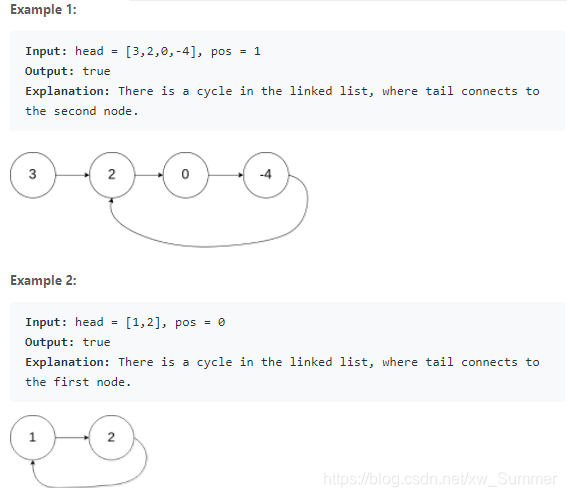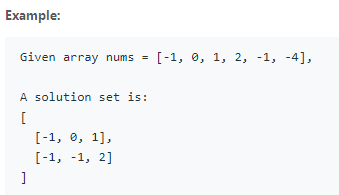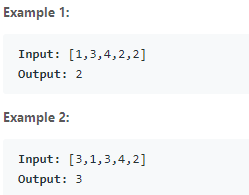easy
283. Move Zeroes
Given an array nums, write a function to move all 0’s to the end of it
while maintaining the relative order of the non-zero elements.Example:
Input: [0,1,0,3,12] Output: [1,3,12,0,0]
Note:
You must do this in-place without making a copy of the array. Minimize
the total number of operations.
Simple O(N) Java Solution Using Insert Index:
class Solution {
// Shift non-zero values as far forward as possible
// Fill remaining space with zeros
public void moveZeroes(int[] nums) {
if (nums == null || nums.length == 0) return;
int insertPos = 0;
for (int num: nums) {
if (num != 0) nums[insertPos++] = num;
}
while (insertPos < nums.length) {
nums[insertPos++] = 0;
}
}
}
141. Linked List Cycle
Given a linked list, determine if it has a cycle in it.
To represent a cycle in the given linked list, we use an integer pos which represents the position (0-indexed) in the linked list where tail connects to. If pos is -1, then there is no cycle in the linked list.
Follow up:Can you solve it using O(1) (i.e. constant) memory?
O(1) Space Solution:
/**
* Definition for singly-linked list.
* class ListNode {
* int val;
* ListNode next;
* ListNode(int x) {
* val = x;
* next = null;
* }
* }
*/
public class Solution {
public boolean hasCycle(ListNode head) {
if(head==null) return false;
ListNode walker = head;
ListNode runner = head;
while(runner.next!=null && runner.next.next!=null) {
walker = walker.next;
runner = runner.next.next;
if(walker==runner) return true;
}
return false;
}
}
解释: Use two pointers, walker and runner. walker moves step by step. runner
moves two steps at time. if the Linked List has a cycle walker and
runner will meet at some point.
234. Palindrome Linked List
Given a singly linked list, determine if it is a palindrome.
Example 1:
Input: 1->2 Output: false
Example 2:
Input: 1->2->2->1 Output: true
Follow up: Could you do it in O(n) time and O(1) space?
Reversing a list is not considered “O(1) space”
It is a common misunderstanding that the space complexity of a program is just how much the size of additional memory space being used besides input. An important prerequisite is neglected the above definition: the input has to be read-only. By definition, changing the input and change it back is not allowed (or the input size should be counted when doing so). Another way of determining the space complexity of a program is to simply look at how much space it has written to. Reversing a singly linked list requires writing to O(n) memory space, thus the space complexities for all “reverse-the-list”-based approaches are O(n), not O(1).
Solving this problem in O(1) space is theoretically impossible due to two simple facts: (1) a program using O(1) space is computationally equivalent to a finite automata, or a regular expression checker; (2) the pumping lemma states that the set of palindrome strings does not form a regular set.
Please change the incorrect problem statement.
Java, easy to understand:
This can be solved by reversing the 2nd half and compare the two
halves. Let’s start with an example [1, 1, 2, 1].In the beginning, set two pointers fast and slow starting at the head.
(1) Move: fast pointer goes to the end, and slow goes to the middle.
(2)
Reverse: the right half is reversed, and slow pointer becomes the 2nd head.
(3) Compare: run the two pointers head and slow together and compare.
/**
* Definition for singly-linked list.
* public class ListNode {
* int val;
* ListNode next;
* ListNode(int x) { val = x; }
* }
*/
class Solution {
public boolean isPalindrome(ListNode head) {
ListNode fast = head, slow = head;
while (fast != null && fast.next != null) {
fast = fast.next.next;
slow = slow.next;
}
if (fast != null) { // odd nodes: let right half smaller
slow = slow.next;
}
slow = reverse(slow);
fast = head;
while (slow != null) {
if (fast.val != slow.val) {
return false;
}
fast = fast.next;
slow = slow.next;
}
return true;
}
public ListNode reverse(ListNode head) {
ListNode prev = null;
while (head != null) {
ListNode next = head.next;
head.next = prev;
prev = head;
head = next;
}
return prev;
}
}
medium
3. Longest Substring Without Repeating Characters
Given a string, find the length of the longest substring without repeating characters.
11-line simple Java solution, O(n) with explanation:
the basic idea is, keep a hashmap which stores the characters in string as keys and their positions as values, and keep two pointers which define the max substring. move the right pointer to scan through the string , and meanwhile update the hashmap. If the character is already in the hashmap, then move the left pointer to the right of the same character last found. Note that the two pointers can only move forward.
class Solution {
public int lengthOfLongestSubstring(String s) {
if (s.length()==0) return 0;
HashMap<Character, Integer> map = new HashMap<Character, Integer>();
int max=0;
for (int i=0, j=0; i<s.length(); ++i){
if (map.containsKey(s.charAt(i))){
j = Math.max(j,map.get(s.charAt(i))+1);
}
map.put(s.charAt(i),i);
max = Math.max(max,i-j+1);
}
return max;
}
}
11. Container With Most Water
Given n non-negative integers a1, a2, …, an , where each represents a point at coordinate (i, ai). n vertical lines are drawn such that the two endpoints of line i is at (i, ai) and (i, 0). Find two lines, which together with x-axis forms a container, such that the container contains the most water.
Note: You may not slant the container and n is at least 2.
The above vertical lines are represented by array [1,8,6,2,5,4,8,3,7]. In this case, the max area of water (blue section) the container can contain is 49.
Easy Concise Java O(N) Solution with Proof and Explanation:
AKA, the general idea to find some max is to go through all cases where max value can possibly occur and keep updating the max value.
The efficiency of the scan depends on the size of cases you plan to scan. To increase efficiency, all we need to do is to find a smart way of scan to cut off the useless cases and meanwhile 100% guarantee the max value can be reached through the rest of cases.
In this problem, the smart scan way is to set two pointers initialized at both ends of the array. Every time move the smaller value pointer to inner array. Then after the two pointers meet, all possible max cases have been scanned and the max situation is 100% reached somewhere in the scan. Following is a brief prove of this.
Given a1,a2,a3…an as input array. Lets assume a10 and a20 are the max area situation. We need to prove that a10 can be reached by left pointer and during the time left pointer stays at a10, a20 can be reached by right pointer. That is to say, the core problem is to prove: when left pointer is at a10 and right pointer is at a21, the next move must be right pointer to a20.
Since we are always moving the pointer with the smaller value, i.e. if a10 > a21, we should move pointer at a21 to a20, as we hope. Why a10 >a21? Because if a21>a10, then area of a10 and a20 must be less than area of a10 and a21. Because the area of a10 and a21 is at least height[a10] * (21-10) while the area of a10 and a20 is at most height[a10] * (20-10). So there is a contradiction of assumption a10 and a20 has the max area. So, a10 must be greater than a21, then next move a21 has to be move to a20. The max cases must be reached.
class Solution {
public int maxArea(int[] height) {
int left = 0, right = height.length - 1;
int maxArea = 0;
while (left < right) {
maxArea = Math.max(maxArea, Math.min(height[left], height[right])
* (right - left));
if (height[left] < height[right])
left++;
else
right--;
}
return maxArea;
}
}
15. 3Sum
Given an array nums of n integers, are there elements a, b, c in nums such that a + b + c = 0? Find all unique triplets in the array which gives the sum of zero.
Note:
The solution set must not contain duplicate triplets.
Concise O(N^2) Java solution:
The idea is to sort an input array and then run through all indices of a possible first element of a triplet. For each possible first element we make a standard bi-directional 2Sum sweep of the remaining part of the array. Also we want to skip equal elements to avoid duplicates in the answer without making a set or smth like that.
class Solution {
public List<List<Integer>> threeSum(int[] num) {
Arrays.sort(num);
List<List<Integer>> res = new LinkedList<>();
for (int i = 0; i < num.length-2; i++) {
if (i == 0 || (i > 0 && num[i] != num[i-1])) {
int lo = i+1, hi = num.length-1, sum = 0 - num[i];
while (lo < hi) {
if (num[lo] + num[hi] == sum) {
res.add(Arrays.asList(num[i], num[lo], num[hi]));
while (lo < hi && num[lo] == num[lo+1]) lo++;
while (lo < hi && num[hi] == num[hi-1]) hi--;
lo++; hi--;
} else if (num[lo] + num[hi] < sum) lo++;
else hi--;
}
}
}
return res;
}
}
19. Remove Nth Node From End of List
Given a linked list, remove the n-th node from the end of list and return its head.
Note:
Given n will always be valid.
Follow up:
Could you do this in one pass?
Simple Java solution in one pass:
A one pass solution can be done using pointers. Move one pointer fast --> n+1 places forward, to maintain a gap of n between the two pointers and then move both at the same speed. Finally, when the fast pointer reaches the end, the slow pointer will be n+1 places behind - just the right spot for it to be able to skip the next node.
Since the question gives that n is valid, not too many checks have to be put in place. Otherwise, this would be necessary.
/**
* Definition for singly-linked list.
* public class ListNode {
* int val;
* ListNode next;
* ListNode(int x) { val = x; }
* }
*/
class Solution {
public ListNode removeNthFromEnd(ListNode head, int n) {
ListNode start = new ListNode(0);
ListNode slow = start, fast = start;
slow.next = head;
//Move fast in front so that the gap between slow and fast becomes n
for(int i=1; i<=n+1; i++) {
fast = fast.next;
}
//Move fast to the end, maintaining the gap
while(fast != null) {
slow = slow.next;
fast = fast.next;
}
//Skip the desired node
slow.next = slow.next.next;
return start.next;
}
}
75. Sort Colors
Given an array with n objects colored red, white or blue, sort them in-place so that objects of the same color are adjacent, with the colors in the order red, white and blue.
Here, we will use the integers 0, 1, and 2 to represent the color red, white, and blue respectively.
Note: You are not suppose to use the library’s sort function for this problem.
Follow up:
A rather straight forward solution is a two-pass algorithm using counting sort.
First, iterate the array counting number of 0’s, 1’s, and 2’s, then overwrite array with total number of 0’s, then 1’s and followed by 2’s.
Could you come up with a one-pass algorithm using only constant space?
Share my at most two-pass constant space 10-line solution:
The idea is to sweep all 0s to the left and all 2s to the right, then all 1s are left in the middle.
It is hard to define what is a “one-pass” solution but this algorithm is bounded by O(2n), meaning that at most each element will be seen and operated twice (in the case of all 0s). You may be able to write an algorithm which goes through the list only once, but each step requires multiple operations, leading the total operations larger than O(2n).
class Solution {
public void sortColors(int[] nums) {
int second=n-1, zero=0;
for (int i=0; i<=second; i++) {
while (A[i]==2 && i<second) swap(A[i], A[second--]);
while (A[i]==0 && i>zero) swap(A[i], A[zero++]);
}
}
}
142. Linked List Cycle II
Given a linked list, return the node where the cycle begins. If there is no cycle, return null.
To represent a cycle in the given linked list, we use an integer pos which represents the position (0-indexed) in the linked list where tail connects to. If pos is -1, then there is no cycle in the linked list.
Note: Do not modify the linked list.
Follow up:
Can you solve it without using extra space?
Java O(1) space solution with detailed explanation:
Define two pointers slow and fast. Both start at head node, fast is twice as fast as slow. If it reaches the end it means there is no cycle, otherwise eventually it will eventually catch up to slow pointer somewhere in the cycle.
Let the distance from the first node to the the node where cycle begins be A, and let say the slow pointer travels travels A+B. The fast pointer must travel 2A+2B to catch up. The cycle size is N. Full cycle is also how much more fast pointer has traveled than slow pointer at meeting point.
A+B+N = 2A+2B
N=A+B
From our calculation slow pointer traveled exactly full cycle when it meets fast pointer, and since originally it travled A before starting on a cycle, it must travel A to reach the point where cycle begins! We can start another slow pointer at head node, and move both pointers until they meet at the beginning of a cycle.
public class Solution {
public ListNode detectCycle(ListNode head) {
ListNode slow = head;
ListNode fast = head;
while (fast!=null && fast.next!=null){
fast = fast.next.next;
slow = slow.next;
if (fast == slow){
ListNode slow2 = head;
while (slow2 != slow){
slow = slow.next;
slow2 = slow2.next;
}
return slow;
}
}
return null;
}
}
287. Find the Duplicate Number
Given an array nums containing n + 1 integers where each integer is between 1 and n (inclusive), prove that at least one duplicate number must exist. Assume that there is only one duplicate number, find the duplicate one.
Note:
- You must not modify the array (assume the array is read only).
- You must use only constant, O(1) extra space.
- Your runtime complexity should be less than O(n2).
- There is only one duplicate number in the array, but it could be repeated more than once.
Java O(n) time and O(1) space solution. Similar to find loop in linkedlist:
suppose the array is
index: 0 1 2 3 4 5
value: 2 5 1 1 4 3
first subtract 1 from each element in the array, so it is much easy to understand.
use the value as pointer. the array becomes:
index: 0 1 2 3 4 5
value: 1 4 0 0 3 2
Second if the array is
index: 0 1 2 3 4 5
value: 0 1 2 4 2 3
we must choose the last element as the head of the linked list. If we choose 0, we can not detect the cycle.
Now the problem is the same as find the cycle in linkedlist!
public int findDuplicate(int[] nums) {
int n = nums.length;
for(int i=0;i<nums.length;i++) nums[i]--;
int slow = n-1;
int fast = n-1;
do{
slow = nums[slow];
fast = nums[nums[fast]];
}while(slow != fast);
slow = n-1;
while(slow != fast){
slow = nums[slow];
fast = nums[fast];
}
return slow+1;
}
One condition is we cannot modify the array. So the solution is:
public int findDuplicate(int[] nums) {
int n = nums.length;
int slow = n;
int fast = n;
do{
slow = nums[slow-1];
fast = nums[nums[fast-1]-1];
}while(slow != fast);
slow = n;
while(slow != fast){
slow = nums[slow-1];
fast = nums[fast-1];
}
return slow;
}














